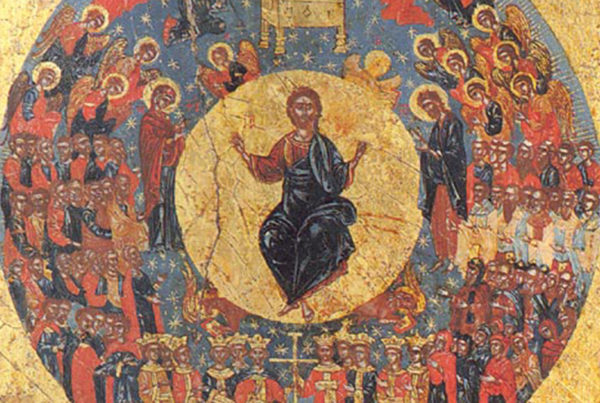Growing up in the non-denominational, evangelical world, my background was largely devoid of robust tradition. By the time I got to my early 20’s, that lack became a great felt need for me. I began to long for rootedness, stability, and a sense of connectedness to the great Tradition of the Church. When I started to experiment with a Christian-calendar centered spirituality in my mid-20s, I found what my soul had been looking for. Years later, the practice (in particular) of a “Holy Lent” has proven annually to be a high point of my walk with Jesus. It strips me, centers me, and renews me in so many ways.
Before we get into the “how” of Lent, however, we should take a minute to understand the “where” and “why” of it. Lent, you see, originated in the very earliest days of the Church. When new converts (catechumens) were preparing for baptism, the seven or so weeks leading up to Easter would be used to help the soon-to-be-initiated understand just what their faith required of them. To be baptized, of course, meant to die with Christ and be raised to new life in the Spirit, and that required two things. First, a stripping off of the old. Second, a putting on of the new. The catechumen was being ushered into an experience of repudiating death-breathing ways in order to embrace the way of life in Christ Jesus, in all its color and complexity.
As this practice grew within the early church, eventually it seemed wise to turn the entire season not just into a time of preparation for the catechumens, but into a time of renewal for the whole congregation. Each year, the congregation would re-enter into the depths of their “baptismal vows” to leave behind death and walk in life. It would be a sort of annual spiritual house-cleaning and stock-taking, with the memory and meaning of baptism at the very center of it. As Robert Webber writes: “The Lenten journey is a baptismal spirituality…To live in one’s baptism is to be continually renewed by the commitment of our original spiritual experience.” (Ancient-Future Time, 112)
Understanding this historical context can help give us a framework for thinking about how to engage the season of Lent. Set within the movement of “stripping off” and “putting on”, we can think about constructing a Lenten spirituality that is both a “no” and a “yes.” We can say “no” to what dissipates us, destroys us, robs us of our energy for love and service, and thwarts human life. And at the same time, we can say “yes” to those things that ground us in God, orient us towards “the other”, and allow the life of Christ to shine in us.
What might that look like? Here are some suggestions:
Saying “No”
- Fast one meal (or one day) per week
- Watch less TV
- Watch no TV
- Take up a social media fast
- Cut out junk food
- Cut out sugar
- Cut out caffeine
- Cut out eating out
- Cut out all of the above
- Weep and wail (because if you follow the previous instruction, you will likely need to)
- Give up cussing
- Give up raising your voice
- Drive less
- Be more thoughtful of destructive mental habits (paranoia, comparison, judgmentalism, etc)
- Give something valuable away (a book, clothes, furniture, money, your car)
The idea here is that you want to think about those things that either pollute you, dissipate you, or harm you and others. Junk food is a pollution. Certain kinds of television are a pollution. Would you be better off without them? Social media and other lazy habits tend to dissipate us. We find ourselves wasting our best energy trolling around the internet and playing silly games, which can put us into a mental and emotional haze. Can we do without those things? Cussing, raising our voices, and engaging in destructive mental habits can harm ourselves and others. Can we fathom giving those things up? And what would life be like if we did? Asking those questions is the heart of the “stripping off” part of Lent.
Saying “yes”
- Eat something green every day
- Make dinner together as a family/couple X amount of nights per week
- Read a chapter from the Gospels in the morning and a Psalm before bed
- Take your lunch break to pray for ten minutes
- Read a novel
- Create something
- Start a blog
- Paint a picture
- Keep a journal
- Write a song
- Listen to good music… choral, orchestral, classical, etc
- Take 5 minutes out of your day to breathe deeply
- Take your spouse, or child, on a weekly date
- Clean something (your house, your desk, your garage, your car, your inbox)
- Find a piece of art that you really connect with, and take time every day to look at it and think about the meaning of it
- Exercise regularly
- Take daily walks
- Find a way each day to affirm or bless someone close to you
- Practice “listening with your heart” to what people say
- Smile more
- Keep a running list that you add to each day of all the things you love about your life
As with “stripping off”, the idea here is to engage in practices that enhance our humanness, consolidate and focus our energies, and lead to a sense of wellbeing and coherence for ourselves and others. The activities need not be explicitly “religious”–they need only orient you towards love of God and neighbor, and respect for yourself and the world around you.
You are welcome, of course, to be creative with all of this, and to make use of what others have done (for instance, check out this really great resource – http://www.catholicallyear.com/2014/02/outside-box-66-things-to-give-up-or.html; you might also be interested in downloading our “Cycle of Life: A Lenten Guide” that we put together at Bloom this year). The key is to identify the deathliness in your life and take intentional steps to walk deliberately into the life.
Grace and peace to you on your journey.
Andrew




One Comment